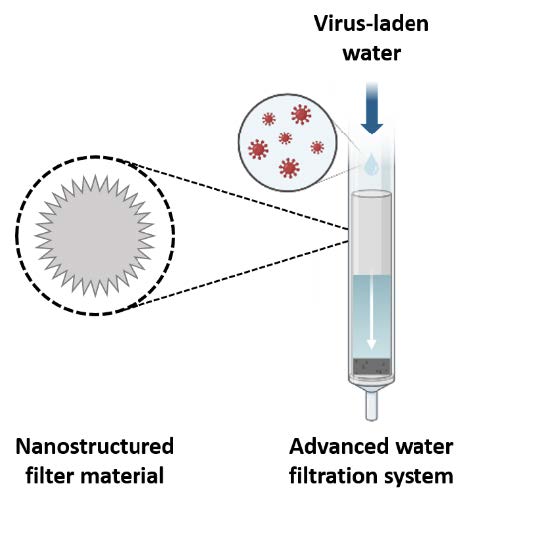Nanostructured materials for multi-viral filtration

Human activities and climate change are increasing the contamination risk posed by water-borne viruses to global water systems1. Conventional approaches for viral filtration from water, such as disinfection (e.g. via chlorination), often require centralized infrastructure with expert monitoring2. Unfortunately, these technical strategies are often inaccessible to underdeveloped or remote communities, and lack the flexibility to deal with emergencies such as natural disasters3. In these instances, simplified approaches such as gravity-based depth filtration are better suited to obtain clean drinking water4.
Depth filtration systems consist of a porous filtration medium to adsorb contaminants from the filtrate, differing from standard filtration techniques which utilize e.g. size exclusion to remove suspended materials at the membrane surface only. A common example of such filters are packed beds of granulated materials, such as the activated carbon found in Brita® water filters. In comparison to other membrane-based technologies, pressure drops are much lower for depth filtration, resulting in reduced energy requirements (if any) and thus lower costs. The driving pressure can be applied via an external pump, or even via the use of hydrostatic pressure, i.e. from the weight of the water to be filtered.
Despite their advantages, state-of-the-art depth filters still have some intrinsic limitations which are yet to be overcome. Viruses are particularly problematic for traditional depth filters due to their small size, requiring highly adsorbent materials which are also capable of processing large flow rates. High surface area nanostructured materials present a promising solution to this challenge5, however, they are typically characterized by high fabrication costs, ruling out their real-world application. Furthermore, metal ion leaching from such nanomaterials poses significant health risks6 which are often not addressed in the academic literature.
At the High Performance Ceramics lab at Empa, we have performed preliminary tests identifying a prom-ising high surface area material for the removal of viruses and bacteria from water. The nanostructures are obtained from cheap and commercially available raw materials, with intrinsic beneficial properties for water-filtration. In collaboration with OST (Rapperswil), we are now investigating the viability of this material as the basis for an advanced filter system for multi-viral filtration (ARMFUL), with the goal of commercialization in the medium-term.
We are looking for a motivated MSc. thesis student to take part in this exciting multi-disciplinary project encompassing aspects of: microbiology, chemical synthesis, colloidal science, and chemical engineering, to help develop and test filters obtained with nanomaterials. You will work under the daily supervision of a Postdoc to optimize the synthesis of the nanostructured material, help design the filtration system, and investigate the range of possible operating conditions for virus filtration. This project is the culmination of a long-standing research line at Empa, and we expect that your work will form part of a future publication. Subject to the performance of the final filtration system, we hope to develop a spin-off if the product is deemed commercially viable.
If you have a curious mind, an appetite for challenges, and the willingness to learn new skills on the job, we would love to hear from you! For further information, please contact Max Bailey ([email protected])
[1] Hunter, P. R. (2003). Journal of applied microbiology, 94(s1), 37-46.
[2] Hashmi, I., Farooq, S., & Qaiser, S. (2009). Environmental monitoring and assessment, 158,
393-403.
[3] Frechen, F. B., et al. (2011). Water Science and Technology: Water Supply, 11(1), 39-44.
[4] Pronk, W., et al. (2019). Water research, 149, 553-565.
[5] Savage, N., & Diallo, M. S. (2005). Journal of Nanoparticle research, 7, 331-342.
Production of metabolic water by bacteria as a strategy for environmental adaptation in alpine and polar environments
Water is the most essential element which directly or indirectly sustains all life forms on Earth. Many animals can only survive for few days in the absence of water. Bacteria, on the other side, can inhabit the driest environments in the planet, such as deserts and glacier ice sheets. In these ecosystems, the presence of liquid water is extremely scarce and water is thus one of the most important limiting factor for biodiversity. Nevertheless, scientists have shown that a wide diversity of bacteria communities can thrive in these extreme ecosystems. But, what adaptation mechanisms allow microbial life in the quasi absence of liquid water?
Bacteria (among other organisms) are capable of producing water as a by-product of their metabolism. This water is known as metabolic water. For years, metabolic water was believed to be of minor quantitative importance as water may potentially freely diffuse through cell membranes. However, recent studies have determined the proportion of metabolic water in the cytoplasm of bacteria by isotope probing. Recent results show that metabolic water can account for 40 to 70% of the water found in the cytoplasm of bacteria in their exponential growth phase. This interesting finding suggests that the production of metabolic water can be much more important for bacteria cells than previously thought.
In this master project, you will contribute to create a collection of bacteria isolates from polar and alpine environments and to quantitatively determine the production of metabolic water in the cultured bacteria under different environmental stressors such as UV radiation, heat and desiccation. The outcomes of this project will allow us to better understand the role of metabolic water production in the adaptation of polar and alpine bacteria to extreme environmental conditions and, secondarily, to determine whether it would be viable to scale-up the production of water in bioreactors so bacteria metabolic water can be used in the future to develop new biotechnological applications, for example as drinking water in space stations or during drought-related emergency situations. Contact us if you are interested!
Contact information: Anna Carratalà ([email protected])